817 Search Results for praactical teaching
April 5, 2018
by Carole Zangari -

Do you work with AAC learners who demonstrate their communication skills in therapy or instructional lessons, but not elsewhere? In this post, we review some things we can do to make it easier for AAC learners to generalize their newly-developed skills and use them in a variety of places with a range of communication partners. Part of the solution to this problem lies in collaborating with the communication partners in other settings. In doing that, we want to be sure that the partners use good communication facilitation strategies, such as these. Partner skills are something we’ve covered here on several occasions. Today, we’ll focus on changes we can make within our direct intervention or instructional lessons with AAC learners. Initially, we may control some of the instructional variables, such as materials and cues, rather tightly. Keeping things consistent is great for the initial teaching of new skills because it allows... [Read More...]
February 22, 2018
by Carole Zangari -
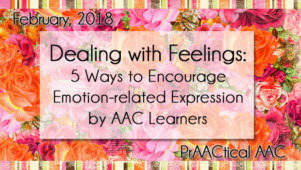
Words for emotions and feelings are pretty common in AAC devices and non-electronic communication aids, like PODD books and eye gaze boards. It’s wonderful when our clients can tell us they are sad or angry with words rather than using challenging behaviors or suffering in silence. What can we do to further their skills in this area? Here are some suggestions to get us thinking. Beyond the Basics: Consider going beyond the basic feeling words (i.e., happy, sad, mad, tired, scared) and including additional emotion words in the AAC system (e.g., frustrated, embarrassed, disappointed, lonely, worried). Don’t assume that this is inappropriate just because an individual has lower language levels or cognitive delays. To learn language, we have to have access to it. Model, model, model: Use these emotion words throughout the day to express your own feelings, and narrate your observations of how others are feeling (e.g., “Joey’s crying... [Read More...]
February 14, 2018
by Carole Zangari -
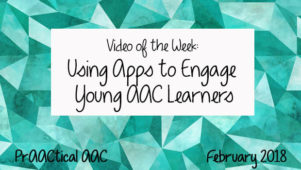
We’re making progress in teaching our little AAC learners. We know the pedagogy and evidence-based strategies. But we still have to figure out how to plan engaging instructional sessions with specific activities and materials. While we like to get kids moving and interacting with toys and other playthings, sometimes we also include play and interaction using educational and recreational apps. But which ones? In today’s featured video, SLP Betsy Furler shares some of her favorites. This video was part of the 2017 AAC in the Cloud Conference and we are grateful to them for making it available. If you liked this and other videos from AAC in the Cloud, you may want to participate in the 2018 AAC in the Cloud Conference this June. Stay tuned for details!
January 18, 2018
by Carole Zangari -
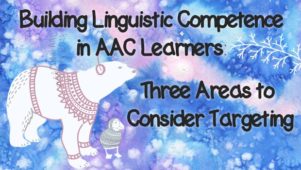
For several years, those who specialize in supporting AAC learners have stressed the need to develop AAC systems and programming that go beyond the communicative function of requesting in order to target the ability to protest, reject, comment, etc. This has been an important trend that will empower users of AAC to express themselves in much fuller ways. What other things should we be targeting in order to help our clients and students become more linguistically competent? Here are some ideas for goal areas to consider. Temporal Markers: While no one can overstate the importance of talking about our current needs, interests, observations, and preferences, we have to be careful not to get stuck in the moment. It is also important for our AAC learners to develop the language skills to be able to talk about things that already happened or that will/might be happening. Why? Among other things, this... [Read More...]
January 16, 2018
by Carole Zangari -
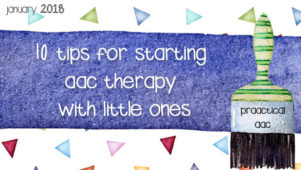
It’s exciting to see so many graduate student SLPs and new graduates who are interested in working with people with AAC needs. We hear from them frequently with questions about how to be effective in their therapy and the practical aspects of running a good therapy session. Here are some tips we frequently share with those who are starting to implement AAC with young children. Use a visual schedule for every session. The operative word there is ‘use.’ Making a schedule for our therapy is a great start, but unless we really use the schedule all throughout the session, it’s unlikely to provide many benefits. Go to it as soon as you get into the room, AND before and after every activity. (For those who are interested, there is more on making and effectively implementing visual schedules here. Trust the process. You will need to do this at least 4-8... [Read More...]
December 18, 2017
by Carole Zangari -
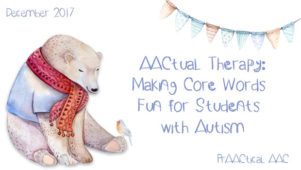
What’s better that modeling AAC? Doing it with a pal, of course! In this post, we hear from special education teacher Carissa Thompson and SLP Hannah Sellers who work at Princeton House Charter School (PHCS) where they serve students with autism spectrum disorder. Both work with students who use a variety of AAC to communicate and access their curricula. PHCS uses a daily integrated language therapy model which allows for increased opportunities to collaborate with teachers and to organically meet the communication needs of their students. Today, Hannah and Carissa share ways in which they team up to provide AAC supports with a fun twist. AAC & Autism: Making Core Words Fun with Bluebee Pals In this post, we would like to introduce you to a recently discovered therapy and classroom tool that has made core words fun for our students! Meet Bluebee Pals Bluebee Pals are a group of... [Read More...]
October 26, 2017
by Carole Zangari -
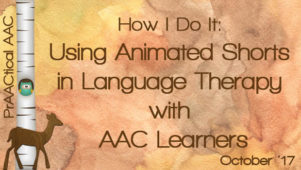
Looking for ways to engage AAC learners in language therapy? Today, we welcome back SLP Rachel Madel to tell us about her experience in using wordless videos. Her prAACtical tips will get you excited about using videos like these, curated by The Activity Tailor, in your lessons. Enjoy! ::::::::::::::::::::::::::::::::::::::::::::::::::::::::::::::::::::::::::::::: Using Animated Shorts to Build Language Skills with AAC Learners We are living in a digital age, where video content is often free and easy to access. Children on my caseload are tech savvy and are constantly dazzling me with how well they can navigate YouTube to find their favorite videos. Motivation is paramount in creating meaningful communication interactions and watching animated videos is highly motivating for both students and clinicians. I’ve had great success utilizing wordless videos in my practice and was lucky enough to present on the topic during “AAC After Work” with a fellow AAC colleague, Susan Berkowitz. In case... [Read More...]
October 9, 2017
by Carole Zangari -
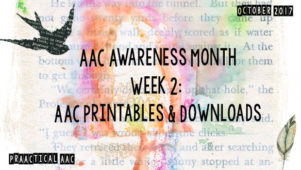
It’s exciting to see how families and professionals around the world are hosting events (see our suggestions here) and doing all sorts of informal activities to build awareness of AAC. In today’s post, we share a variety of materials that can be printed and/or shared. Print and display an AAC Poster. From CoughDrop: Keys to Modeling From Rachael Langley: Subway Art From Lauren Enders: AAC Do/Do Not From Kate Ahern: The Periodic Table of AAC From Noodle Nook: 5 Tips for Communicating with Nonverbal Students From Scope: Speak Up and Be Safe From PrAACtical AAC: More Teaching, Less Testing Share handouts Print, hang, or give someone an AAC awareness image 10 Commandments of AAC Devices Hanen Center: Tips for Parents of Children Who Communicate Without Words Susan Berkowitz: Partner Strategies for Augmentative Communication Scope: AAC Strategies in Healthcare Settings Have fun with AAC memes created by a variety of people
October 5, 2017
by Carole Zangari -
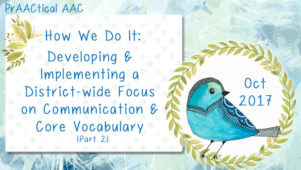
We’re back with Georgia-based SLP Jennifer Ro to hear more about a district-wide rollout of AAC in which they established (and have maintained) a core vocabulary focus. Jennifer is currently the lead AAC-SLP on Forsyth County Schools’ Assistive Technology Team where she provides AAC implementation support and trainings for staff and families and conducts individual AAC student consults. You can see Part 1 of the post here. Today, Jennifer shares some of what they learned in the process of creating AAC materials for the classroom and supporting the implementation of those materials. Let’s continue with more ‘lessons learned’ from this AAC experience. ================= How We Do It: Developing, Implementing a District-wide Focus on Communication & Core Vocabulary (Part 2) How we did it. And keep doing it … 😉 Create and develop supplemental materials that can be utilized universally and then modified, if needed, for individual student or teacher... [Read More...]
September 18, 2017
by Carole Zangari -
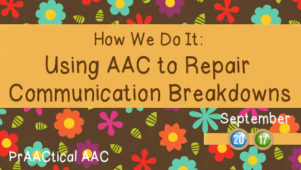
We’ve had many nice comments about the resources shared by AAC SLP Alicia Garcia, clinical lead of the AAC Clinic at One Kids Place, a children’s treatment centre in northern Ontario. With over two decades of experience in pediatric rehabilitation practice in private and public settings, Alicia’s ideas for how to support AAC learners and their families are tried and true. In today’s post, Alicia shares thoughts and materials for situations in which the AAC is needed to repair communication breakdowns. :::::::::::::::::::::::::::::::::::::::::::::::::::::::::::::::::::::::::::::::::::::::::::::::: Children with unclear speech not only have different intelligibility levels but also different levels of awareness, focus, and interest on repairing their communication breakdowns. We use different approaches based on how they react and respond when they are not understood. As a general guideline when a communication breakdown occurs, regardless of the child’s profile, we first try determining the level of urgency or importance of the child’s intended... [Read More...]









